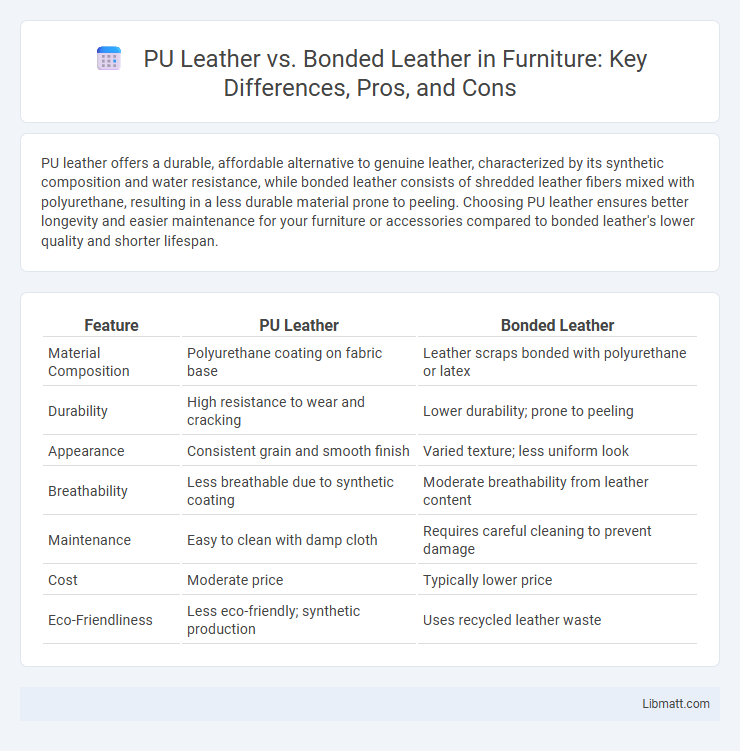PU leather offers a durable, affordable alternative to genuine leather, characterized by its synthetic composition and water resistance, while bonded leather consists of shredded leather fibers mixed with polyurethane, resulting in a less durable material prone to peeling. Choosing PU leather ensures better longevity and easier maintenance for your furniture or accessories compared to bonded leather's lower quality and shorter lifespan.
Table of Comparison
| Feature | PU Leather | Bonded Leather |
|---|---|---|
| Material Composition | Polyurethane coating on fabric base | Leather scraps bonded with polyurethane or latex |
| Durability | High resistance to wear and cracking | Lower durability; prone to peeling |
| Appearance | Consistent grain and smooth finish | Varied texture; less uniform look |
| Breathability | Less breathable due to synthetic coating | Moderate breathability from leather content |
| Maintenance | Easy to clean with damp cloth | Requires careful cleaning to prevent damage |
| Cost | Moderate price | Typically lower price |
| Eco-Friendliness | Less eco-friendly; synthetic production | Uses recycled leather waste |
Understanding PU Leather: Composition and Features
PU leather is a synthetic material composed of a polyurethane coating applied to a fabric base, usually polyester, offering durability and water resistance. Its textured surface mimics genuine leather, providing an affordable and animal-friendly alternative with easy maintenance. You benefit from PU leather's balance of flexibility and aesthetic appeal, making it popular in furniture and fashion industries.
What is Bonded Leather? Materials and Manufacturing
Bonded leather is a material composed of shredded leather scraps combined with a polyurethane or latex binder, pressed onto a fiber or fabric backing to create a continuous surface. Unlike PU leather, which is a synthetic material made by coating a fabric base with a layer of polyurethane, bonded leather includes genuine leather fibers making it less durable but more affordable. Your choice between these materials depends on preferences for texture, durability, and cost-effectiveness in upholstery or fashion products.
Appearance and Texture: PU vs Bonded Leather
PU leather offers a smooth, consistent appearance with a uniform texture that mimics genuine leather, often featuring a glossy or matte finish depending on manufacturing. Bonded leather has a more varied texture due to its composition of leather scraps bonded together, resulting in less uniformity and often a rougher feel with visible inconsistencies. PU leather generally provides a sleeker, more polished aesthetic, while bonded leather tends to have a coarser texture and a more uneven surface.
Durability Comparison: Which Lasts Longer?
PU leather offers superior durability compared to bonded leather due to its synthetic composition, which resists cracking, peeling, and wear over time. Bonded leather, made from shredded genuine leather mixed with polyurethane, tends to deteriorate faster as the fibers break down and the surface peels away. For long-lasting applications, PU leather is generally the preferred choice due to its enhanced resilience and consistent performance.
Maintenance and Care Tips
PU leather requires regular wiping with a damp cloth and occasional conditioning using products specifically designed for synthetic materials to prevent cracking and maintain its appearance. Bonded leather needs gentle cleaning with a mild soap solution and careful avoiding of excess moisture to preserve the adhesive bonds and texture. Your maintenance routine should emphasize avoiding direct sunlight and heat sources for both materials to extend their durability and aesthetic appeal.
Cost Differences: PU Leather vs Bonded Leather
PU leather generally costs more than bonded leather due to its higher durability and closer resemblance to genuine leather. Bonded leather is made from leather scraps bonded with polyurethane or latex, making it significantly cheaper but less durable. The price disparity reflects PU leather's enhanced quality, lifespan, and appeal compared to the more economical bonded leather option.
Environmental Impact and Sustainability
PU leather involves synthetic materials derived from polyurethane, offering greater durability and easier recyclability compared to bonded leather, which combines shredded genuine leather scraps with adhesives, resulting in a less eco-friendly composite. Bonded leather's manufacturing process consumes more chemical binders and generates more waste, leading to higher environmental toxicity and landfill burden. Choosing PU leather supports reduced resource extraction and promotes more consistent eco-conscious production practices, enhancing sustainability in leather alternatives.
Common Uses in Furniture, Fashion, and Automotive
PU leather is widely used in furniture upholstery due to its durability and ease of maintenance, making it a popular choice for sofas and chairs. In fashion, PU leather is favored for jackets, bags, and shoes, offering a cost-effective alternative to genuine leather with a similar appearance. Automotive interiors often incorporate PU leather for seats and trim because it withstands wear and is easier to clean compared to bonded leather, which is typically less durable and used in budget furniture and lower-end fashion accessories.
Pros and Cons: PU Leather at a Glance
PU leather offers affordable durability with a smooth, consistent texture ideal for fashion accessories and upholstery. It resists water and stains better than bonded leather but may crack and peel over time, especially with heavy use. Although less breathable than genuine leather, PU leather is a cruelty-free alternative that is easier to clean and maintain.
Pros and Cons: Bonded Leather Reviewed
Bonded leather, made from leather scraps bonded with polyurethane or latex, offers an affordable and eco-friendly alternative to genuine leather. Its main advantages include a lower price point and a smooth, consistent surface, while drawbacks involve reduced durability, potential peeling, and a less authentic texture compared to PU leather. Understanding bonded leather's pros and cons helps you make informed choices for furniture or accessories that balance cost and quality.
PU Leather vs Bonded Leather Infographic

 libmatt.com
libmatt.com